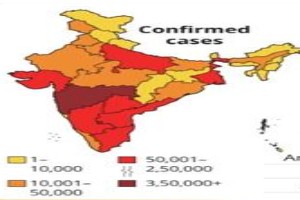
[the_ad_placement id=”adsense-in-feed”]
New Delhi/Geneva: Fresh confirmed COVID-19 cases in India breached the 50,000 mark on a single day in the last 24 hours ending 8 am on Thursday. The total number of confirmed cases reported during this period was 52,123 and 4,46,642 samples were tested in the last 24 hours. Because of the pandemic ,775 deaths were reported across the country during this period. The total number of confirmed COVID-19 cases has now reached 15.83,792 with 5,28,242 active cases and total 34,968 deaths in the country. In all 10,20,582 patients have recovered till date. The Ministry of Health and Family Welfare stated on Thursday that 16 States/Union Territories exceeded the National Recovery Average of 64.44%.
The worst affected state, Maharashtra crossed 4 Lakh mark of reported Covid 19 cases on Wednesday. With 9,211 patients testing positive for COVID-19, the state tally of coronavirus infection has gone up to 4,00,651. However, the number of active cases was 1,46,129. On the same day, 7,478 patients recovered throughout the state. This tooj the count of recovered patients to 2,39,755. However, 298 deaths were also reported in the state, taking the state’s death toll to 14,463.
Meanwhile, Maharashtra has extended the lockdown till Aug 31 with situation in other cities and towns like Pune, Sangli, Nasik, Kolhapur still remaining grim. The night curfew will remain in place across the state.
[the_ad_placement id=”content-placement-after-3rd-paragraph”]
More than 40% of COVID-19-related deaths linked to long-term care facilities: WHO
In the meantime, the World Health Organisation (WHO) on Thursday stated that in many countries, more than 40% of COVID-19-related deaths were linked to long-term care facilities, and up to 80% in some high-income countries.
Recognizing the critical nature of this issue, WHO released a policy brief on preventing and managing COVID-19 in long-term care facilities. The brief listed key actions that must be taken by policy-makers and national and local authorities to protect older people. These ranged from integrating long-term care in the national response, to mobilizing adequate funding, to ensuring strong infection prevention and control, to providing support for family and voluntary caregivers – “and much more”.
For each policy objective, the document listed actions that long-term care facilities could take, and gave real-world examples of actions countries had taken in each area. The brief also suggested ways to transform long-term care services so that older people could receive quality care that respected their rights, freedoms and dignity.
The WHO further warned that although older people were at a higher risk of severe disease, younger people were at risk too. One of the challenges, it stated, was to convince younger people of this risk.
“Evidence suggests that spikes of cases in some countries are being driven in part by younger people letting down their guard during the northern hemisphere summer…Young people can be infected; young people can die; and young people can transmit the virus to others,” WHO Director-General Dr.Tedros Adhanom Ghebreyesus told media persons in Geneva on Thursday.
– globalbihari bureau
[the_ad_placement id=”sidebar-feed”]





